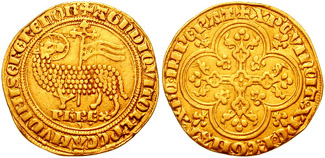- About MAA
- Membership
- MAA Publications
- Periodicals
- Blogs
- MAA Book Series
- MAA Press (an imprint of the AMS)
- MAA Notes
- MAA Reviews
- Mathematical Communication
- Information for Libraries
- Author Resources
- Advertise with MAA
- Meetings
- Competitions
- Programs
- Communities
- MAA Sections
- SIGMAA
- MAA Connect
- Students
- MAA Awards
- Awards Booklets
- Writing Awards
- Teaching Awards
- Service Awards
- Research Awards
- Lecture Awards
- Putnam Competition Individual and Team Winners
- D. E. Shaw Group AMC 8 Awards & Certificates
- Maryam Mirzakhani AMC 10 A Awards & Certificates
- Two Sigma AMC 10 B Awards & Certificates
- Jane Street AMC 12 A Awards & Certificates
- Akamai AMC 12 B Awards & Certificates
- High School Teachers
- News
You are here
'He Advanced Him 200 Lambs of Gold': The Pamiers Manuscript - Prices and Purchases
Each of our next two sample problems entails a set of purchases that can be analyzed as a system of linear relationships.
The first is stated in terms of the sous, a coin mentioned earlier, and the setier, a measure of volume for liquids and grains that is roughly two gallons (it was one of the units swept away by the French Revolution). See whether you can figure it out.
Problem 3. A merchant paid 10 liras, which is 200 sous, for two manners of grain, namely wheat and oats, and he purchased each setier of wheat for 10 sous and each setier of oats for 5 sous. This merchant turned around and sold his grain, selling each setier of oats for 4 sous and each setier of wheat for 12 sous, and realized a profit of 10 sous. I ask how many setiers of wheat and how many of oats he purchased, and how much money he paid for each grain. (Sesiano 1984, p. 56)
The other sample problem mentions a gold coin of France called a “lamb of gold” (moto d’aur in Languedocian or mouton d’or in modern French, cognate with the English word “mutton”). It was worth 12½ sous. The coin contained an image of a lamb accompanied by a Latin inscription to Christ, who is often referred to by Christians as Agnus Dei, the Lamb of God. See the photograph of a moto (a moto photo!) below.

Figure 9. A “lamb of gold” coin from France, this one struck in the year 1311. Abbreviated in Latin is an invocation to Christ, Agnus dei qui tollit peccata mundi miserere nobis (“Lamb of God who bears the sins of the world, take pity on us”). (Image: Classical Numismatic Group, Inc. / Wikimedia Commons, licensed under the GNU Free Documentation License.)
Problem 4. A merchant purchased three pieces of cloth that cost him [a total of] 30 motos, and doesn’t know with certainty what each of the pieces cost, but does know that the second cost double the first and 4 more; the third cost three times as much as the second, less 7. I ask what each one cost. (Sesiano 1984, p. 55)
Solutions to Problem 4 by double false position and by algebra
Randy K. Schwartz (Schoolcraft College), "'He Advanced Him 200 Lambs of Gold': The Pamiers Manuscript - Prices and Purchases," Convergence (July 2012), DOI:10.4169/loci003888




